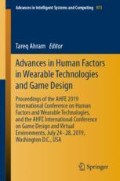Abstract
The purpose of this study was to suggest the design of wearable robots based on the shoulder kinematics including the range of motion, angular velocity, and angular acceleration during walking. A treadmill system was used to measure the kinematics data of the shoulder joint during different walking speed. The independent variables of this study were walking speed. Walking speed was set as four levels including 3.6, 5.4, 7.2, and preferred walking speed (PWS) km/h. The subject walked according to the randomized walking speed during 90 s on the treadmill. Twenty gait cycles of motion capture data from each experimental condition of each subject were extracted. Data was analyzed by one-way repeated measures analysis of variance. There were significant differences of minimum joint angle, mean of ROM, maximum joint angular velocity, minimum joint angular velocity, maximum joint angular acceleration and minimum joint angular acceleration. There was no significant difference of maximum joint angle. The kinematics data of ROM, angular velocity, and angular acceleration revealed an increasing trend up to walking speed of 7.2 km/h. It indicates that the arm swinging was sufficiently performed to maintain the walking stability. The maximum angular acceleration increased as the walking speed increased, which meant the instantaneous velocity of the shoulder joint increased. It indicated that the load of the shoulder joint increased with the increase of the walking speed. Hence, this study suggests that the ergonomic threshold for walking speed of the wearable robot could be limited to 5.4 km/h.
Access this chapter
Tax calculation will be finalised at checkout
Purchases are for personal use only
References
Alami, R., Albu-Schaeffer, A., Bicchi, A., Bischoff, R., Chatila, R., De Luca, A., De Santis, A., Giralt, G., Guiochet, J., Hirzinger, G., Ingrand, F., Lippiello, V., Mattone, R., Powell, D., Sen, S., Siciliano, B., Tonietti, G., Villani, L.: Safe and dependable physical human-robot interaction in anthropic domains: state of the art and challenges. In: 2006 IEEE/RSJ International Conference on Intelligent Robots and Systems. https://doi.org/10.1109/iros.2006.6936985 (2006)
Riani, A., Madani, T., Benallegue, A., Djouani, K.: Adaptive integral terminal sliding mode control for upper-limb rehabilitation exoskeleton. Control. Eng. Pract. 75, 108–117 (2018)
Bergamasco, M., Salsedo, F., Marcheschi, S.: A novel actuator for wearable robots with improved torque density and mechanical efficiency. Adv. Robot. 24, 2019–2041 (2012)
Copaci, D., Cano, E., Moreno, L., Blanco, D.: New design of a soft robotics wearable elbow exoskeleton based on shape memory alloy wire actuators. Appl. Bionics. Biomech. https://doi.org/10.1155/2017/1605101 (2017)
Asbeck, A.T., De Rossi, S.M., Galiana, I., Ding, Y., Walsh, C.J.: Stronger, smarter, softer: next-generation wearable robots. IEEE Robot. Autom. Mag. 21, 22–33 (2014)
Browning, R.C., Modica, J.R., Kram, R., Goswami, A.: The effects of adding mass to the legs on the energetics and biomechanics of walking. Med. Sci. Sports. Exerc. 39, 515–525 (2007)
Pons, J.L.: Wearable Robots: Biomechatronic Exoskeletons. Wiley, UK (2008)
Bilney. B., Morris. M., Webster. K.: Concurrent related validity of the GAITRite® walkway system for quantification of the spatial and temporal parameters of gait. Gait. Posture. 17, 68–74 (2003)
Kang, H.G., Dingwell, J.B.: Separating the effects of age and walking speed on gait variability. Gait. Posture. 27, 572–577 (2008)
Zeni Jr, J.A., Richards, J.G., Higginson, J.S.: Two simple methods for determining gait events during treadmill and overground walking using kinematic data. Gait. Posture. 27, 710–714 (2008)
Ortega, J.D., Fehlman, L.A., Farley, C.T.: Effects of aging and arm swing on the metabolic cost of stability in human walking. J. Biomech. 41, 3303–3308 (2008)
Umberger, B.R.: Effects of suppressing arm swing on kinematics, kinetics, and energetics of human walking. J. Biomech. 41, 2575–2580 (2008)
Bruijn, S.M., Meijer, E.G., Beek, P.J., van Dieën, J.H.: The effects of arm swing on human gait stability. J. Exp. Biol. 213, 3945–3952 (2010)
Acknowledgments
This study was supported by Basic Science Research Program through the National Research Foundation of Korea (NRF) funded by the Ministry of Education (NRF-2017R1D1A3B03035407).
Author information
Authors and Affiliations
Corresponding author
Editor information
Editors and Affiliations
Rights and permissions
Copyright information
© 2020 Springer Nature Switzerland AG
About this paper
Cite this paper
Mo, SM., Hwang, J., Kim, J.H., Jung, MC. (2020). The Ergonomic Design of Wearable Robot Based on the Shoulder Kinematic Analysis by Walking Speed. In: Ahram, T. (eds) Advances in Human Factors in Wearable Technologies and Game Design. AHFE 2019. Advances in Intelligent Systems and Computing, vol 973. Springer, Cham. https://doi.org/10.1007/978-3-030-20476-1_8
Download citation
DOI: https://doi.org/10.1007/978-3-030-20476-1_8
Published:
Publisher Name: Springer, Cham
Print ISBN: 978-3-030-20475-4
Online ISBN: 978-3-030-20476-1
eBook Packages: EngineeringEngineering (R0)

